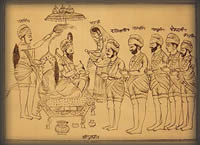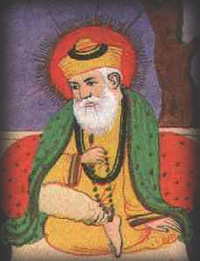
Guru Gobind Singh initiating the panj piara
(Woodcut,
c 1874-5)
In 1699 CE, the tenth Sikh guru, Guru Gobind Singh, chose Baisakhi as the occasion to pass the mantle of authority from the succession of human gurus to the collection of Sikh scriptures; previously known as the Adi Granth (‘original collection’), this set of texts would henceforth be known as guru, specifically the Guru Granth Sahib (‘collection of sacred wisdom’).
It was also on this occasion that he would seek a spectacular leap of faith from several of his followers. At the time, the Sikh community was under assault by the Muslim ruler of India. Addressing the assembly gathered for the Baisakhi celebrations, Gobind Singh highlighted this threat, proclaiming that weakness would have to be replaced with unity and strength if they were to survive.
With uplifted sword, he asked if there were any in the crowd so loyal that they would offer up their heads to him. At first there was no response. And then one man stepped forward and was led into the guru’s tent. When Gobind Singh emerged with a bloodied sword, there was hushed silence, and then four more brave souls ventured forward. They followed him into the tent and the crowd waited, expecting that only the guru would emerge. But when he did finally appear, he was not alone; all five volunteers came with him, their heads solidly attached.
The first Sikh guru, Guru Nanak, was another individual who did not find satisfaction with the religion of his ancestors. Born into a Hindu family he lived in an area that was heavily populated by Muslims, and as a teenager he had explored Islam as an alternative to the faith to which he was born.

Guru Nanak
To an outsider this kind of account verges on the fantastical; how are we to consider it in order to understand? When it is said of Nanak that he spent two days immersed under water only to emerge on the third possessing the amrit, what reality is reflected by this myth?
Think of the times when something happened to you that took you away from all that was outward; when some emotional turmoil—for instance, a great loss or a falling in love—withdrew you from the world. And to go back to the story of Nanak and the amrit, caught in the tension between two beliefs as he was, think how sweet it would be to experience a transcendent solution. For this is what he brought back to his village, a way of expressing faith that drew on both traditions yet was unique unto itself.
Baisakhi procession in
Southall, London
led by the panj piara
Sikh communities over the world celebrate Baisakhi with ceremonial processions, at the front of which can be seen five men representing the original panj piara, the ‘five beloved’ companions that had risked their heads for the faith.
Thousands of men and women were subsequently initiated on that day, pledging to stay true to the code of discipline set down by Gobind Singh. The first guru, Guru Nanak, had attracted a following with his straightforward devotion. By Gobind Singh’s time, however, the growing numbers of Sikhs had attracted the enmity of the ruling Moghuls; Gobind Singh himself had become guru when the Moghuls beheaded his predecessor.
His subsequent innovations furthered the transformation of the Panjabi farmers into a collection of warriors capable of protecting their community. “When all other means have failed,” he said, “it is righteous to draw the sword.” And this, I believe, is a powerful lesson: that although on occasion it is an expression of devotion to turn the other cheek, at other times it is equally divine to show one’s sword and stand up in our own defense.